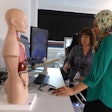
As medical malpractice cases rise across Europe, radiologists can reduce the risk of lawsuits by being vigilant in documenting their diagnoses and information given to patients, advises Dr. Markus Ludvik, a Vienna-based specialist medical lawyer.
About half of successful malpractice cases have nothing to do with the diagnosis but rather the failure to inform the patient about all the complications that can occur during treatment, and that's where good records are crucial. "You need to document as well as possible to separate your [role] from other doctors," said Ludvik, who addressed legal risks during ECR 2015.
 At Vienna's Allgemeines Krankenhaus, most malpractice claims are sorted out by mediation, says Dr. Markus Ludvik. (Photo copyright M. Ludvik)
At Vienna's Allgemeines Krankenhaus, most malpractice claims are sorted out by mediation, says Dr. Markus Ludvik. (Photo copyright M. Ludvik)He recommends taking these steps to minimize exposure to legal challenges:
Keep written and electronic records of evaluations for a minimum of 10 years. Doubling up on records provides a paper trail that can help determine if the defendant gave a correct diagnosis and passed that information along to the treating physician.
Don't create your own shorthand. Use abbreviations that are common -- and not private ones -- because the interpretation is impossible afterward.
Have a medical colleague on hand to witness diagnostic explanations to patients and/or their family members who may not be fluent in the language you are using, and when no official translator is available. Keep a written record of what was said.
Malpractice cases in Austria have increased rapidly in recent years, Ludvik told AuntMinnieEurope.com in an interview. This "disease of litigosis" stems partly from more patients taking out insurance against medical error and lawyers willing to file claims.
Legal challenges over alleged medical error are growing, though precise figures are difficult to come by because many complaints are settled out of court. In 2010, there were more than 9,384 cases reported in Austria, a 47% increase from 6,407 five years earlier.
Roughly 1 in 10 patients admitted to a European hospital complained of complications from the treatment they receive, according to the EU's 2009 Communication on Patient Safety.1 Ecclesia, a German insurance and risk management group that maintains a medical malpractice database, logs 11,000 new claims annually in Europe.
Devil in the details
Radiologists may find themselves at an inherent disadvantage in malpractice challenges, Ludvik explained. In busy hospitals, the radiologist has limited opportunities for a personal discussion with the patients, underlining the need for a paper trail that can help courts or mediators identify potential errors and minimize the chance of a conflict between physicians over who is at fault. Therefore, meticulous records can be especially important for radiologists, who may have limited personal contact with patients being treated by other specialists.
"This documentation has to be legible. There is always a problem that many, many physicians still [only] have handwritten documentation," he said, adding that it is best to have both a written record ("It is more authentic because you can't really manipulate it,") and electronic files.
Other factors that expose doctors to lawsuits include advancements in technology and demands for using more precise imaging capabilities that run the risk of higher radiation exposure.Better technologies provide wider possibilities for diagnosis, but also require better training and education, according to Ludvik.
"You have to be trained on this machinery, on these new imaging systems," he noted. "Sometimes you just don't even have the time to educate yourself and to train yourself."
He credits professional organizations with providing training and education in developing evaluation and treatment techniques, including in the field of interventional radiology.
Language barriers
Yet another risk has less to do with technology and more to do with language, and the recent influx of refugees from the Middle East conflicts is an example. The number of asylum seekers to the EU grew by 44% in 2014 and by 60% in Austria, where more than 28,000 people sought political refuge last year, according to recent data from the EU statistical office.2
"It's a problem in Austria right now," Ludvik said, explaining that in some cases neither the patient nor their relatives can communicate with the doctors. "If you give the information to them they will say 'yes, yes, yes' but they don't understand."
Again, his main recommendation is to keep good records of what was explained to the patient and have another health professional on hand as a witness.
In addition to factors cited by Ludvik, analysts pin the cause of rising litigiousness in Europe to factors such as greater advocacy for patient rights and publicity about mistakes that inevitably do occur.
A 2013 study of radiology malpractice cases by researchers at the Sapienza University in Rome showed that in Italy, and much of Europe, wrong diagnoses accounted for 66.7% of lawsuits against radiologists, with the leading mistakes involving the skeletal system, breast, chest, and abdomen.3
The fields of radiology, obstetrics/gynecology, emergency medicine, and anesthesia are at particular risk of legal challenges, according to an Organization for Economic Cooperation and Development report on tort law and medical liability.4 Still, tort law in many European countries makes legal claims difficult because the burden for hiring lawyers and paying court costs falls more heavily on the plaintiff. Headline-grabbing damage awards are rare.
Ludvik said the vast majority of malpractice complaints at Vienna's largest hospital, the Allgemeines Krankenhaus, are handled through mediation involving the doctors, patient, legal counsel, and insurance firms. The hospital treats some 2 million patients in a typical year, and only about 15 malpractice complaints go to court. An increasing number of cases that do go before a judge involve optional cosmetic surgery rather than medical error. "The patients look in the mirror and they are not satisfied with the success and that's it," he concluded.
References
- Official Journal of the European Union. Council recommendation of 9 June 2009 on patient safety, including the prevention and control of healthcare associated infections. (2009/C 151/01).
- The number of asylum applicants in the EU jumped to more than 625 000 in 2014. Eurostat news release No. 53/2015, 20 March 2015.
- Cannavale A, Santoni M, Mancarella P, Passariello R, Arbarello P.Malpractice in Radiology: What Should You Worry About? Radiol Res Pract. 2013;2013:219259.
- Medical Malpractice Prevention, Insurance and Coverage Options. OECD Publishing; 5 December 2006.
















